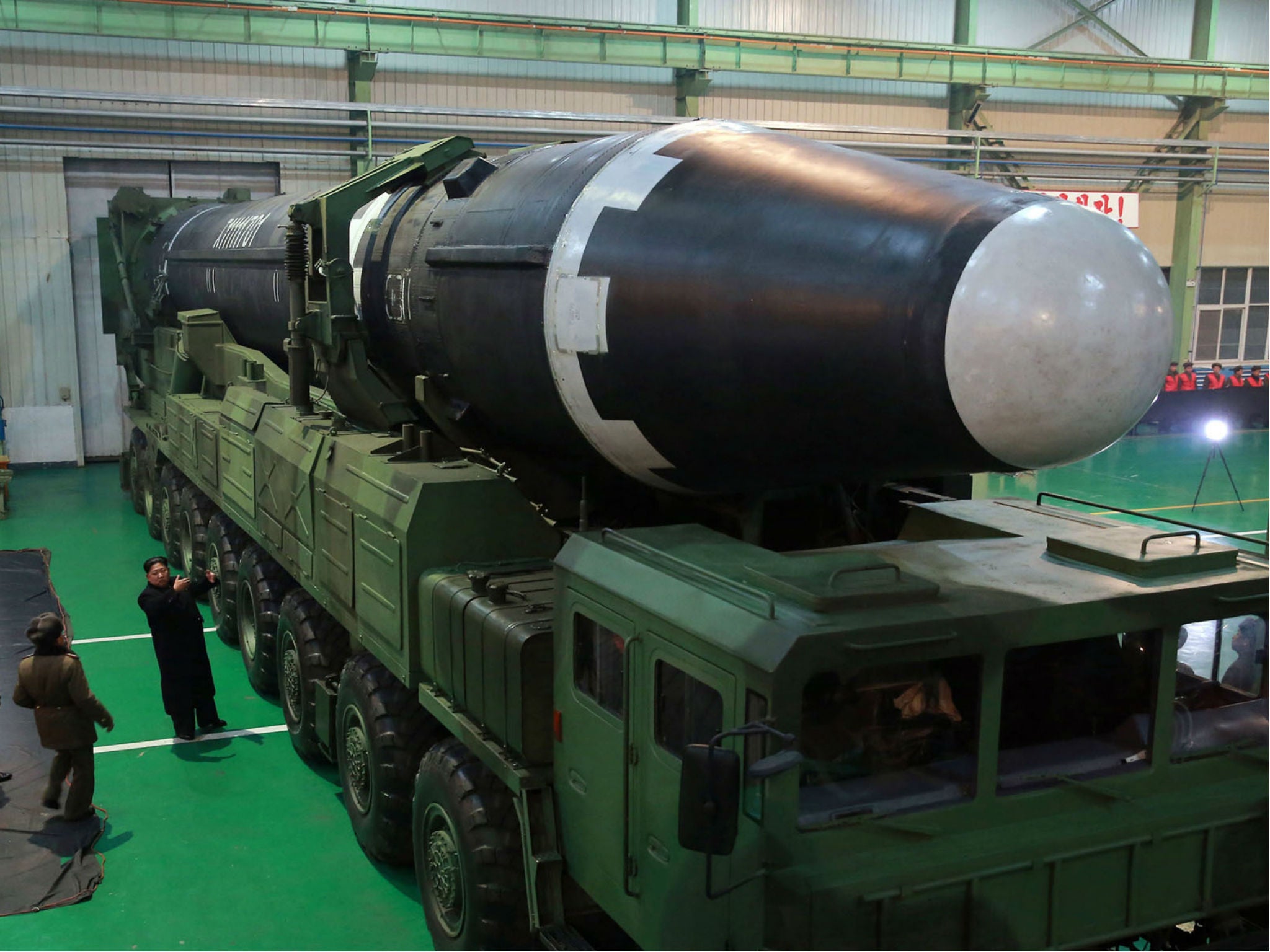North Korea's latest missile much more technologically advanced than predecessors, experts warn
Hwasong-15 likened to American Titan II, used by US Air Force and Nasa to launch space shuttles

Your support helps us to tell the story
From reproductive rights to climate change to Big Tech, The Independent is on the ground when the story is developing. Whether it's investigating the financials of Elon Musk's pro-Trump PAC or producing our latest documentary, 'The A Word', which shines a light on the American women fighting for reproductive rights, we know how important it is to parse out the facts from the messaging.
At such a critical moment in US history, we need reporters on the ground. Your donation allows us to keep sending journalists to speak to both sides of the story.
The Independent is trusted by Americans across the entire political spectrum. And unlike many other quality news outlets, we choose not to lock Americans out of our reporting and analysis with paywalls. We believe quality journalism should be available to everyone, paid for by those who can afford it.
Your support makes all the difference.A day after its latest intercontinental ballistic missile launch, North Korea released photos of what it's calling the “Hwasong-15.” And the collective response from missile experts was - not to get too technical - whoa.
The missile and its launcher truck do, at first blush, appear to support North Korea's claim that this missile is much more technologically advanced than previous iterations.
Although there is still much that can't be gleaned from the photos and North Korea does have an inglorious record of exaggeration, analysts generally agree that the Hwasong-15 marks a significant leap forward in North Korea's missile development.
“This is a really big missile, much larger than I expected,” said Scott LaFoy, an imagery analyst for the specialist website NK News. “I believe one of my professors would have referred to it as a big honking missile.”
Several analysts noted that the missile looked like the American Titan II, which was initially an ICBM but was then later used by the US Air Force and Nasa as a space launch vehicle.
The truck: The transporter erecter launcher, or TEL, has nine axles, making it one axle longer than the TEL used to launch the previous iteration of the intercontinental ballistic missile. North Korea claims to have made these trucks itself but analysts believe they are modified versions or based on the Chinese lumber truck, the WS51200.
“We've seen heavy vehicle extensions before but this would this would be a very large step forward for their heavy vehicles industry,” said LaFoy, estimating that the truck was about twice as long as an American school bus. “We know that this is pretty difficult. It took China a while to figure this out.”
The nose cone: The nose cone of the Hwasong-15 is much blunter than of the previous iteration, the Hwasong-14. This is likely an effort to slow down the missile slightly as it screams through the atmosphere, which lowers the heat inside the missile and means that the warhead doesn't have to withstand quite as much variation in temperature during flight.
This might be an effort to overcome issues with the re-entry vehicle - the part of the missile that protects the warhead during launch and brings it back into the Earth's atmosphere. This is one of the parts of the missile that North Korea has not yet proven it has mastered.
The size of the nose cone and re-entry vehicle on the Hwasong-15 supports North Korea's claim that the missile can carry a “super large heavy warhead.” But experts think the missile tested this week was carrying a light, mock warhead.
The Hwasong-14 and 15 missiles are likely to have carried only very small payloads, which exaggerate the range that a North Korean missile can fly, said Michael Elleman, senior fellow for missile defence at the International Institute for Strategic Studies. Basically, the heavier the warhead, the shorter the distance it can travel.
If the Hwasong-15 was fitted with a half-ton payload and flown on a standard trajectory, it could probably fly about 5,300 miles, Elleman wrote for 38 North, a website devoted to North Korea, meaning that a 600 kilogrammes (1,320 pound) payload “barely reaches Seattle.”
Still, with its publication of this huge re-entry vehicle, Kim's regime is clearly signalling that this is their ultimate goal.
Engines: The first stage of the Hwasong-15 - the bottom part that propels it off the launcher, sometimes called the “booster” - has two engines. “We're trying to figure out what those may be and how powerful they are,” said David Wright of the Union of Concerned Scientists.
But the second stage looks like it can carry more than twice as much propellant as the Hwasong-14, since it is longer and has a larger diameter, Wright said. “The combination of those two things means it really is a new, more capable missile.”
The addition of two engines doubled the second stage thrust and allows the missile to reach a higher peak altitude, Elleman said. This missile reached a height of about 2,800 miles - or ten times as high as the International Space Station.
Steering: The Hwasong-14 had only one nozzle and it used four vernier engines to steer the missile. But the newly unveiled Hwasong-15 has two nozzles and no verniers. That suggests the missile is steered by gimbaling, a more advanced way to control the missile.
“This is a sort of manoeuvring which is pretty fancy. You lose the least thrust that way,” said LaFoy. “We knew they'd get there eventually but we didn't think the North Koreans were there yet.”
The Washington Post
Join our commenting forum
Join thought-provoking conversations, follow other Independent readers and see their replies
Comments